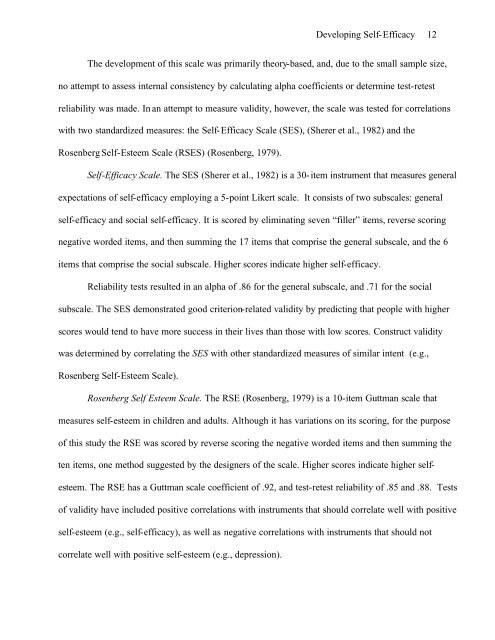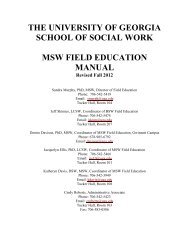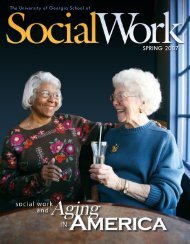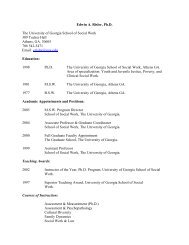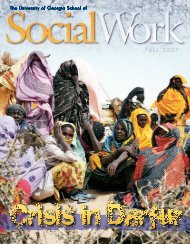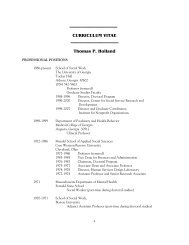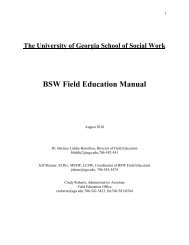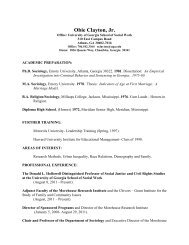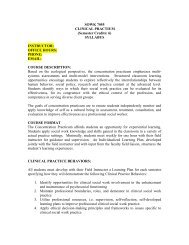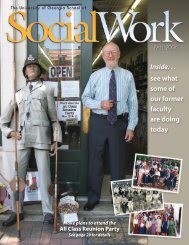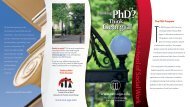Developing Self-Efficacy in MSW Students Through Service-Learning
Developing Self-Efficacy in MSW Students Through Service-Learning
Developing Self-Efficacy in MSW Students Through Service-Learning
You also want an ePaper? Increase the reach of your titles
YUMPU automatically turns print PDFs into web optimized ePapers that Google loves.
<strong>Develop<strong>in</strong>g</strong> <strong>Self</strong>-<strong>Efficacy</strong> 12The development of this scale was primarily theory-based, and, due to the small sample size,no attempt to assess <strong>in</strong>ternal consistency by calculat<strong>in</strong>g alpha coefficients or determ<strong>in</strong>e test-retestreliability was made. In an attempt to measure validity, however, the scale was tested for correlationswith two standardized measures: the <strong>Self</strong>-<strong>Efficacy</strong> Scale (SES), (Sherer et al., 1982) and theRosenberg <strong>Self</strong>-Esteem Scale (RSES) (Rosenberg, 1979).<strong>Self</strong>-<strong>Efficacy</strong> Scale. The SES (Sherer et al., 1982) is a 30-item <strong>in</strong>strument that measures generalexpectations of self-efficacy employ<strong>in</strong>g a 5-po<strong>in</strong>t Likert scale. It consists of two subscales: generalself-efficacy and social self-efficacy. It is scored by elim<strong>in</strong>at<strong>in</strong>g seven “filler” items, reverse scor<strong>in</strong>gnegative worded items, and then summ<strong>in</strong>g the 17 items that comprise the general subscale, and the 6items that comprise the social subscale. Higher scores <strong>in</strong>dicate higher self-efficacy.Reliability tests resulted <strong>in</strong> an alpha of .86 for the general subscale, and .71 for the socialsubscale. The SES demonstrated good criterion-related validity by predict<strong>in</strong>g that people with higherscores would tend to have more success <strong>in</strong> their lives than those with low scores. Construct validitywas determ<strong>in</strong>ed by correlat<strong>in</strong>g the SES with other standardized measures of similar <strong>in</strong>tent (e.g.,Rosenberg <strong>Self</strong>-Esteem Scale).Rosenberg <strong>Self</strong> Esteem Scale. The RSE (Rosenberg, 1979) is a 10-item Guttman scale thatmeasures self-esteem <strong>in</strong> children and adults. Although it has variations on its scor<strong>in</strong>g, for the purposeof this study the RSE was scored by reverse scor<strong>in</strong>g the negative worded items and then summ<strong>in</strong>g theten items, one method suggested by the designers of the scale. Higher scores <strong>in</strong>dicate higher selfesteem.The RSE has a Guttman scale coefficient of .92, and test-retest reliability of .85 and .88. Testsof validity have <strong>in</strong>cluded positive correlations with <strong>in</strong>struments that should correlate well with positiveself-esteem (e.g., self-efficacy), as well as negative correlations with <strong>in</strong>struments that should notcorrelate well with positive self-esteem (e.g., depression).


